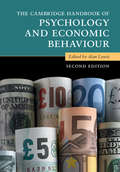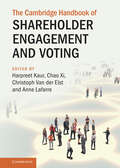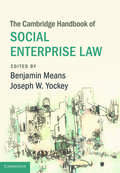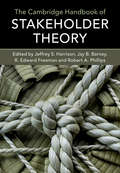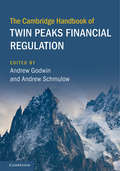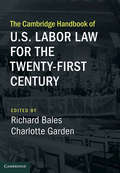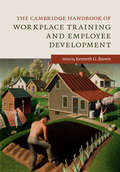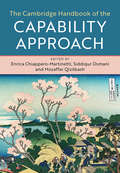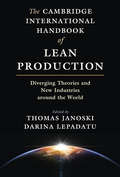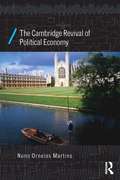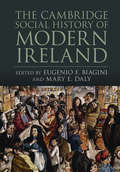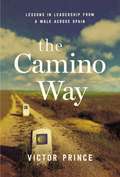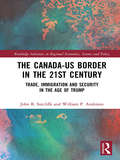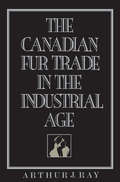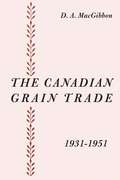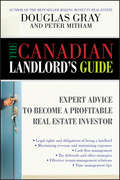- Table View
- List View
The Cambridge Handbook of Meeting Science
by Allen, Joseph A. and Lehmann-Willenbrock, Nale and Rogelberg, Steven G. Joseph A. Allen Nale Lehmann-Willenbrock Steven G. RogelbergThis first volume to analyze the science of meetings offers a unique perspective on an integral part of contemporary work life. More than just a tool for improving individual and organizational effectiveness and well-being, meetings provide a window into the very essence of organizations and employees' experiences with the organization. The average employee attends at least three meetings per week and managers spend the majority of their time in meetings. Meetings can raise individuals, teams, and organizations to tremendous levels of achievement. However, they can also undermine effectiveness and well-being. The Cambridge Handbook of Meeting Science assembles leading authors in industrial and organizational psychology, management, marketing, organizational behavior, anthropology, sociology, and communication to explore the meeting itself, including pre-meeting activities and post-meeting activities. It provides a comprehensive overview of research in the field and will serve as an invaluable starting point for scholars who seek to understand and improve meetings.
The Cambridge Handbook of Psychology and Economic Behaviour
by Alan LewisPsychologists have been observing and interpreting economic behaviour for at least fifty years, and the last decade, in particular, has seen an escalated interest in the interface between psychology and economics. The Cambridge Handbook of Psychology and Economic Behaviour is a valuable reference resource dedicated to improving our understanding of the economic mind and economic behaviour. Employing empirical methods - including laboratory experiments, field experiments, observations, questionnaires and interviews - the Handbook covers aspects of theory and method, financial and consumer behaviour, the environment and biological perspectives. With contributions from distinguished scholars from a variety of countries and backgrounds, the Handbook is an important step forward in the improvement of communications between the disciplines of psychology and economics. It will appeal to academic researchers and graduates in economic psychology and behavioural economics.
The Cambridge Handbook of Psychology and Economic Behaviour (Cambridge Handbooks in Psychology)
by Alan LewisPsychologists have been observing and interpreting economic behaviour for at least fifty years, and the last decade, in particular, has seen an escalated interest in the interface between psychology and economics. The Cambridge Handbook of Psychology and Economic Behaviour is a valuable reference resource dedicated to improving our understanding of the economic mind and economic behaviour. Employing empirical methods - including laboratory experiments, field experiments, observations, questionnaires and interviews - the Handbook covers aspects of theory and method, financial and consumer behaviour, the environment, and biological perspectives. With contributions from distinguished scholars from a variety of countries and backgrounds, the Handbook is an important step forward in the improvement of communications between the disciplines of psychology and economics. It will appeal to academic researchers and graduates in economic psychology and behavioural economics.
The Cambridge Handbook of Shareholder Engagement and Voting (Cambridge Law Handbooks)
by Chao Xi Harpreet Kaur Van der Elst, Christoph Anne LafarreAll over the world, companies play an important role in the economy. Different types of stakeholders hold the reins in these companies. An important class are the shareholders that finance the activities of these companies. In return, stakeholders have a say on how these companies should be organized and structure their activities. This is primarily done through voting and engaging. These mechanisms of voting and engaging allow the shareholders to decide significant aspects of the company structure, from who governs it to how much directors are paid. However, how shareholders vote and engage and how far their rights stretch are organized differently in different countries. This pioneering book provides insights into what rights these shareholders have and how the shareholders of companies in nineteen different jurisdictions participate in corporate life through voting and engaging. Comparative and international in scope, it pays particular attention to how jurisdictions align and differ around the world.
The Cambridge Handbook of Social Enterprise Law
by Benjamin Means Joseph W. YockeyGrowing numbers of employees, consumers, and investors want companies to be truly good; these stakeholders will accept lower economic returns in order to support companies that prioritize sustainability, fair wages, and fair trade. Unlike charities or non-profit organizations, such companies - or social enterprises - are not only permitted but also expected to produce an economic return for investors. Yet, unlike traditional business ventures, social enterprises have no obligation to maximize profits, even on a long-term basis. In this comprehensive volume, Benjamin Means and Joseph W. Yockey bring together leading legal scholars and practitioners to offer an authoritative guide to social enterprise law and policy. The Cambridge Handbook of Social Enterprise Law takes stock of the field and charts a course for its future development. It should be read by entrepreneurs, investors, practitioners, academics, students and anyone else interested in how companies are evolving to address new demands for capitalism with a conscience.
The Cambridge Handbook of Stakeholder Theory
by R. Edward Freeman Jeffrey S. Harrison Jay B. Barney Robert A. PhillipsIn the decades since R. Edward Freeman first introduced stakeholder theory, which views firms in terms of their relationships to a broad set of partners, the stakeholder approach has drawn increasing attention as a model for ethical business. Edited by Freeman, alongside other leading scholars in stakeholder theory and strategic management, this handbook provides a comprehensive foundation for study in the field, with eighteen chapters covering some of the most important topics in stakeholder theory written by respected and highly cited experts. The chapters contain an overview of the topic, an examination of the most important research on the topic to date, an evaluation of that research, and suggestions for future directions. Given the pace of new scholarship in the field, this handbook will provide an essential reference on both foundational topics as well as new applications of stakeholder theory to entrepreneurship, sustainable business, corporate responsibility, and beyond.
The Cambridge Handbook of Twin Peaks Financial Regulation (Cambridge Law Handbooks)
by Andrew Godwin Andrew SchmulowFirst proposed in 1994, the Twin Peaks model of financial system regulation employs two specialist peak regulators: one charged with the maintenance of financial system stability, and the other with market conduct and consumer protection. This volume, with contributions from over thirty scholars and senior regulators, provides an in-depth analysis of the similarities and differences in the Twin Peaks regimes that have been adopted around the world. Chapters examine the strengths and weaknesses of the model, provide lessons from Australia (the first to adopt the model), and offer a comparative look at the potential suitability of the model in leading non-Twin Peaks jurisdictions. A key resource for central bankers, public policy analysts, lawyers, economists, politicians, academics and students, this work provides readers with a comprehensive understanding of the Twin Peaks model, and a roadmap for countries considering its adoption.
The Cambridge Handbook of U.S. Labor Law for the Twenty-First Century (Cambridge Law Handbooks)
by Richard Bales Charlotte GardenOver the last fifty years in the United States, unions have been in deep decline, while income and wealth inequality have grown. In this timely work, editors Richard Bales and Charlotte Garden - with a roster of thirty-five leading labor scholars - analyze these trends and show how they are linked. Designed to appeal to those being introduced to the field as well as experts seeking new insights, this book demonstrates how federal labor law is failing today's workers and disempowering unions; how union jobs pay better than nonunion jobs and help to increase the wages of even nonunion workers; and how, when union jobs vanish, the wage premium also vanishes. At the same time, the book offers a range of solutions, from the radical, such as a complete overhaul of federal labor law, to the incremental, including reforms that could be undertaken by federal agencies on their own.
The Cambridge Handbook of Workplace Training and Employee Development (Cambridge Handbooks in Psychology)
by Brown Kenneth G.With comprehensive coverage of topics related to learning, training, and development, this volume is a must-have resource for industrial and organizational (I/O) psychologists, human resource (HR) scholars, and adult education specialists. Brown provides a forward-looking exploration of the current research on workplace training, employee development, and organizational learning from the primary point of view of industrial organizational psychology. Each chapter discusses current practices, recent research, and, importantly, the gaps between the two. In analyzing these aspects of the topic, the chapter authors both present the valuable knowledge available and show the opportunities for further study and practice.
The Cambridge Handbook of the Capability Approach
by Enrica Chiappero-Martinetti Mozaffar Qizilbash Siddiqur OsmaniThis landmark handbook collects in a single volume the current state of cutting-edge research on the capability approach. It includes a comprehensive introduction to the approach as well as new research from leading scholars in this increasingly influential multi-disciplinary field, including the pioneers of capability research, Martha C. Nussbaum and Amartya Sen. Incorporating both approachable introductory chapters and more in-depth analysis relating to the central philosophical, conceptual and theoretical issues of capability research, this handbook also includes analytical and measurement tools, as well as policy approaches which have emerged in the recent literature. The handbook will be an invaluable resource for students approaching the capability approach for the first time as well as for researchers engaged in advanced research in a wide range of disciplines, including development studies, economics, gender studies, political science and political philosophy.
The Cambridge History of Capitalism: From 1848 to the Present
by Jeffrey G. Williamson Larry NealThe second volume of The Cambridge History of Capitalism provides an authoritative reference on the spread and impact of capitalism across the world, and the varieties of responses to it. Employing a wide geographical coverage and strong comparative outlook, a team of leading scholars explore the global consequences that capitalism has had for industry, agriculture and trade, along with the reactions by governments, firms and markets. The authors consider how World War I halted the initial spread of capitalism, but global capitalism arose again by the close of the twentieth century. They explore how the responses of labor movements, compounded by the reactions by political regimes, whether defensive or proactive, led to diverse military and welfare consequences. Beneficial results eventually emerged, but the rise and spread of capitalism has not been easy or smooth. This definitive volume will have widespread appeal amongst historians, economists and political scientists.
The Cambridge International Handbook of Lean Production: Diverging Theories and New Industries around the World
by Thomas Janoski Darina LepadatuThis handbook focuses on two sides of the lean production debate that rarely interact. On the one hand, management and industrial engineering scholars have presented a positive view of lean production as the epitome of efficiency and quality. On the other hand, sociology, industrial relations, and labor relations scholars focus on work speedups, management by stress, trade union positions, and self-exploitation in lean teams. The editors of this volume understand the merits of both views and present them accordingly, bridging the gaps among five disciplines and presenting the best of each perspective. Chapters by internationally acclaimed authors examine the positive, negative and neutral possible effects of lean, providing a global view of lean production while adjusting lean to the cultural and political contexts of different nation-states. As the first multi-lens view of lean production from academic and consultant perspectives, this volume charts a way forward in the world of work and management in our global economy.
The Cambridge Introduction to Performance Theory
by Simon ShepherdWhat does 'performance theory' really mean and why has it become so important across such a large number of disciplines, from art history to religious studies and architecture to geography? In this introduction Simon Shepherd explains the origins of performance theory, defines the terms and practices within the field and provides new insights into performance's wide range of definitions and uses. Offering an overview of the key figures, their theories and their impact, Shepherd provides a fresh approach to figures including Erving Goffman and Richard Schechner and ideas such as radical art practice, performance studies, radical scenarism and performativity. Essential reading for students, scholars and enthusiasts, this engaging account travels from universities into the streets and back again to examine performance in the context of political activists and teachers, countercultural experiments and feminist challenges, and ceremonies and demonstrations.
The Cambridge Revival of Political Economy (Economics as Social Theory)
by Nuno Ornelas MartinsThe marginalist revolution of the late nineteenth century consolidated what Karl Marx and Piero Sraffa called ‘vulgar economy’, bringing with it an emphasis on a scarcity theory that replaced the classical surplus theory. However, the classical political economy of Adam Smith and David Ricardo has been revived within the Cambridge economic tradition. This book looks at how different branches of the Cambridge economic tradition have focused on various aspects of this revival over time. The author shows that classical political economy is distinct from vulgar political economy in terms of its economic, social, and ethical theory, with each difference resting on an issue of ontology. Structured in three parts, the book examines the central contested aspects of these theories, namely the nature of value, the relationship between human beings and social structure, and the nature of human wellbeing. The Cambridge Revival of Political Economy will be relevant to students and researchers within the fields of political economy, history of economic thought, politics and philosophy.
The Cambridge Social History of Modern Ireland
by Mary E. Daly Biagini Eugenio F.Covering three centuries of unprecedented demographic and economic changes, this textbook is an authoritative and comprehensive view of the shaping of Irish society, at home and abroad, from the famine of 1740 to the present day. The first major work on the history of modern Ireland to adopt a social history perspective, it focuses on the experiences and agency of Irish men, women and children, Catholics and Protestants, and in the North, South and the diaspora. An international team of leading scholars survey key changes in population, the economy, occupations, property ownership, class and migration, and also consider the interaction of the individual and the state through welfare, education, crime and policing. Drawing on a wide range of disciplinary approaches and consistently setting Irish developments in a wider European and global context, this is an invaluable resource for courses on modern Irish history and Irish studies.
The Camino Way: Lessons in Leadership from a Walk Across Spain
by Victor PrinceStretching across 500 miles of northern Spain, the Camino de Santiago has been a pilgrimage route for a millennium. Each year, hundreds of thousands of peregrinos make their way through rugged countryside and medieval towns in order to reflect, test their will, and join a community of strangers on a shared mission. In short, it's the ideal training ground for authentic leadership.Challenged to walk the Camino, Victor Prince began his trek as one person: driven, work-focused and highly competitive, and he finished it a very different one: more balanced, more caring, and more present in the moment. In this transformative book he guides readers on their own Camino, translating his experience into seven essential leadership lessons inspired by the values emblazoned on the back of every pilgrim's passport:Treat each day as its own adventureMake others feel welcomeLearn from those who've walked beforeConsider your impact on those who followAnd moreLeadership is a journey. The Camino Way prepares you to tackle it with a pilgrim's heart, a wayfarer's grit, and a leader's vision.
The Campbell Home (A)
by Matthew Preble Leslie K. JohnCampbell siblings Thomas and Sally are faced with selling their childhood home. They need to make several difficult consequential decisions, all the while navigating their contentious relationship. Did it make sense to hire a broker, or should they go it alone? How much was the home worth? What should the listing price be? Most importantly, what combination of answers would get them the best outcome? And along the way, as they gather information to answer these questions, several unforeseen events occur.
The Campbell Home (B)
by Matthew Preble Leslie K. JohnCampbell siblings Thomas and Sally are faced with selling their childhood home. They need to make several difficult consequential decisions, all the while navigating their contentious relationship. Did it make sense to hire a broker, or should they go it alone? How much was the home worth? What should the listing price be? Most importantly, what combination of answers would get them the best outcome? And along the way, as they gather information to answer these questions, several unforeseen events occur.
The Campbell Home (C)
by Matthew Preble Leslie K. JohnCampbell siblings Thomas and Sally are faced with selling their childhood home. They need to make several difficult consequential decisions, all the while navigating their contentious relationship. Did it make sense to hire a broker, or should they go it alone? How much was the home worth? What should the listing price be? Most importantly, what combination of answers would get them the best outcome? And along the way, as they gather information to answer these questions, several unforeseen events occur.
The Canada Pension Plan Investment Board (CPP Investments): April 2021
by Josh Lerner Reza Satchu Alys FerragamoThe Canada Pension Plan Investment Board (CPPIB) is one of the largest pools of investment capital in the world and follows a rigorous "Total Portfolio Framework" in its approach to investment management. In April of 2021, John Graham was just two months into his role as Chief Executive Officer, and he must decide how to lead the organization to outperform the increasingly competitive market. CPPIB had several structural and developed competitive advantages, but with assets under management projected to grow to C$1 trillion by 2030, Graham faced the challenge of scaling the organization's investment strategy for the future. As Graham settled into the chief executive's role, would he be able to lead CPPIB to meet its strategic goals?
The Canada Pension Plan Investment Board: October 2012
by Josh Lerner Matthew Rhodes-Kropf Nathaniel BurbankThe Canada Pension Plan Investment Board (CPPIB) is one of the largest and fastest-growing pools of investment capital in the world and follows an unusually active program of investment management. In October of 2012, Mark Wiseman was just 12 weeks into his role as chief executive officer, and he must decide how to lead the organization to outperform the market as it grows larger and more geographically disperse. After seven years of eschewing the use of intermediaries and successfully practicing its "do-it-yourself mega-investing" approach, CPPIB had garnered admiration from institutions on Bay Street and Wall Street alike. It had even been heralded as a "Maple Revolutionary" by The Economist. With assets under management projected to grow to C$275 billion by 2020, however, Wiseman faced the challenge of how to scale the organization's investment strategy for the future. As Wiseman settled into the chief executive's role, would he be able to lead CPPIB to meet its goals?
The Canada-US Border in the 21st Century: Trade, Immigration and Security in the Age of Trump (Routledge Advances in Regional Economics, Science and Policy)
by William P. Anderson John B. SutcliffeBorders are critical to the development and survival of modern states, offer security against external threats, and mark public policy and identity difference. At the same time, borders, and borderlands, are places where people, ideas, and economic goods meet and intermingle. The United States-Canada border demonstrates all of the characteristics of modern borders, and epitomises the debates that surround them. This book examines the development of the US-Canada border, provides a detailed analysis of its current operation, and concludes with an evaluation of the border’s future. The central objective is to examine how the border functions in practice, presenting a series of case studies on its operation. This book will be of interest to scholars of North American integration and border studies, and to policy practitioners, who will be particularly interested in the case studies and what they say about the impact of border reform.
The Canadian Fur Trade in the Industrial Age
by Arthur RayThroughout much of the nineteenth century the Hudson's Bay Company had a virtual monopoly on the core area of the fur trade in Canada. Its products were the object of intense competition among merchants on two continents - in Leipzig, New York, London, Winnipeg, St Louis, and Montreal. But in 1870 things began to change, and by the end of the Second World War the company's share had dropped to about a quarter of the trade. Arthur Ray explores the decades of transition, the economic and technological changes that shaped them, and their impact on the Canadian north and its people.Among the developments that affected the fur trade during this period were innovations in transportation and communication; increased government involvement in business, conservation, and native economic welfare; and the effects of two severe depressions (1873-95 and 1929-38) and two world wars.The Hudson's Bay Company, confronting the first of these changes as early as 1871, embarked on a diversification program that was intended to capitalize on new economic opportunities in land development, retailing, and resource ventures. Meanwhile it continued to participate in its traditional sphere of operations. But the company's directors had difficulty keeping pace with the rapid changes that were taking place in the fur trade, and the company began to lose ground.Ray's study is the first to make extensive use of the Hudson's Bay Company archives dealing with the period between 1870 and 1945. These and other documents reveal a great deal about the decline of the company, and thus about a key element in the history of the modern Canadian fur trade.
The Canadian Grain Trade, 1931-1951
by Duncan MacGibbon<p>This book traces in an accurate and objective manner the sequence of events during the last twenty years which have influenced the organization fo the Canadian grain trade. During these years problems arising out of the production and marketing of western grain have been under continuous review in Canada, leading at different times to royal commissions of inquiry. The production and sale of cereals have become such a vital part of the economic life of the three prairie provinces and, indeed, of Canada, that anything affecting this great industry becomes at once a subject of general interest. <p>These twenty years have witnessed momentous changes. The period marks a shift from free trading on the open market to the compulsory marketing of Canadian wheat and other grains through the medium of a Federal board endowed with wide powers. Basically, this change stems from conditions arising out of the Great Depression and World War II. And in one form or another the Canadian Wheat Board will continue to be a significant factor in the marketing of Canadian wheat. Noteworth also have been the dramatic recovery of the Pools and the negotiation of international agreements; and, on the farm front, the establishment of a permit system to control deliveries of grain to country elevators, and the enactment of legislation to protect producers against losses arising from the hazards of nature.</p>
The Canadian Landlord's Guide: Expert Advice for the Profitable Real Estate Investor
by Peter Mitham Douglas GrayThe ultimate resource for Canadian residential landlords. Anyone can become a landlord, but not everyone will be a profitable landlord. Distilling over 35 years of his first-hand experience, Doug Gray, one of Canada’s most respected real estate authors and experts, guides readers on how to become a successful landlord. Following the effective and proven formula of his previous bestsellers, The Canadian Landlord Guide fills the void of information on Canadian landlording. Some of the covered topics include: Principles and formulas for profitable landlording Understanding how the real estate market works The pitfalls of real estate investing and how to avoid them Types of rental formats Where to get information on prospective properties How to finance real estate investments The legal aspects of buying and renting property Tenant selection Property maintenance Filled with easy-to-understand and credible advice, The Canadian Landlord Guide is a must-have resource for all Canadian landlords. Seasoned professionals and aspiring beginners alike will find Doug Gray’s landlording guide to be one of their key tools in their quest for real estate success. Doug Gray, B.A., LL.B. (Vancouver, BC) has been buying, renovating, and renting real estate for 35 years. In addition to being a successful real estate entrepreneur, Doug has written over 28 bestselling real estate, business, and personal finance titles, including Making Money in Real Estate (978-0-470-83620-0) and The Canadian Snowbird Guide (978-0-470-15375-8).

